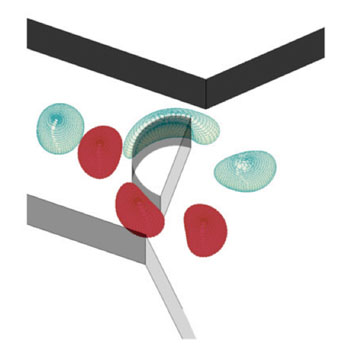Microfluidic Device Could Improve Biomarker Analyses
|
By LabMedica International staff writers Posted on 08 Jul 2014 |

Image: Visualization from a numerical simulation of a cell flowing past the obstacle through the microfluidic device (Image courtesy of KTH – The Royal Institute of Technology).
A new microfluidic device could offer a more reliable alternative for detecting biomarkers in patients facing such illnesses as cancer or malaria.
The physical attributes of cells are important biomarkers in medicine, whether extracting circulating tumor cells from the blood of a cancer patient, or to measure the elasticity of red blood cells due to malaria infection.
Scientists at The Royal Institute of Technology (KTH; Stockholm, Sweden) proposed a microfluidic device that can sort elastic capsules by their deformability. The device consists of a duct embedded with a semi-cylindrical obstacle, and a diffuser which further enhances the sorting capability. The KTH team used extensive computational simulations to model a microfluidic device that would sort cells according to their elasticity. The work draws on numerical techniques and computational capabilities developed in the last decade to handle the complexity of microscale flows.
Most cell sorting techniques rely on the difference between chemical properties of the cells. The problem is chemical properties do not give pathologists the full picture. Two cells can have very similar chemical properties, but different physical properties. Size, shape and elasticity, or deformability, are important attributes that can be also enable cell sorting, given the right kind of device.
The scientists demonstrated that the device can operate reasonably well under changes in the initial position of the capsule. The efficiency of the device remains essentially unaltered under small changes of the obstacle shape from semicircular to semi-elliptic cross-section. Confinement along the direction perpendicular to the plane of the device increases its efficiency. This work is the first numerical study of cell sorting by a realistic microfluidic device.
Dhrubaditya Mitra, PhD, an assistant professor in theoretical physics and a coauthor of the study offers an example of why elasticity matters. “If you are infected with malaria, the physical nature of your red blood cells changes. They become harder and red blood cells also become harder as they get older too. These harder red blood cells are filtered by the spleen which acts like a sieve. The softer red blood cells can squeeze through the gaps but the harder ones cannot.” The study was published on June 20, 2014, in the journal Soft Matter.
Related Links:
The Royal Institute of Technology
The physical attributes of cells are important biomarkers in medicine, whether extracting circulating tumor cells from the blood of a cancer patient, or to measure the elasticity of red blood cells due to malaria infection.
Scientists at The Royal Institute of Technology (KTH; Stockholm, Sweden) proposed a microfluidic device that can sort elastic capsules by their deformability. The device consists of a duct embedded with a semi-cylindrical obstacle, and a diffuser which further enhances the sorting capability. The KTH team used extensive computational simulations to model a microfluidic device that would sort cells according to their elasticity. The work draws on numerical techniques and computational capabilities developed in the last decade to handle the complexity of microscale flows.
Most cell sorting techniques rely on the difference between chemical properties of the cells. The problem is chemical properties do not give pathologists the full picture. Two cells can have very similar chemical properties, but different physical properties. Size, shape and elasticity, or deformability, are important attributes that can be also enable cell sorting, given the right kind of device.
The scientists demonstrated that the device can operate reasonably well under changes in the initial position of the capsule. The efficiency of the device remains essentially unaltered under small changes of the obstacle shape from semicircular to semi-elliptic cross-section. Confinement along the direction perpendicular to the plane of the device increases its efficiency. This work is the first numerical study of cell sorting by a realistic microfluidic device.
Dhrubaditya Mitra, PhD, an assistant professor in theoretical physics and a coauthor of the study offers an example of why elasticity matters. “If you are infected with malaria, the physical nature of your red blood cells changes. They become harder and red blood cells also become harder as they get older too. These harder red blood cells are filtered by the spleen which acts like a sieve. The softer red blood cells can squeeze through the gaps but the harder ones cannot.” The study was published on June 20, 2014, in the journal Soft Matter.
Related Links:
The Royal Institute of Technology
Latest Technology News
- New Noninvasive Methods Detect Lead Exposure Faster, Easier and More Accurately at POC
- Noninvasive Test Detects Malaria Without Blood Sample
- Low-Cost, Portable Device Detects Colorectal and Prostate Cancer in An Hour
- Light-AI Cancer Diagnosis Technology Could Eliminate Need for Traditional Blood Draws and Biopsies
- Chip-Based Blood Test Accurately Diagnoses Heart Attack in Minutes
- Cheap, Paper-Based Testing Platform Could Transform Diagnostics
- New Serological Pipet Controller Features Groundbreaking Repeat Dispense Ability
- Breath-Based Sampling System Diagnoses Lower Respiratory Tract Infection
- POCT Device Monitors C-Reactive Protein Levels Associated with Inflammation in Real Time
- New Microfluidics Method to Speed Up Blood Analyses
- AI Tongue Analysis Model 98% Accurate in Detecting Diseases
- Microneedle Patch Detects Skin Cancer Early
- New Diagnostic System Achieves PCR Testing Accuracy
- DNA Biosensor Enables Early Diagnosis of Cervical Cancer
- Self-Heating Microfluidic Devices Can Detect Diseases in Tiny Blood or Fluid Samples
- Breakthrough in Diagnostic Technology Could Make On-The-Spot Testing Widely Accessible
Channels
Clinical Chemistry
view channel.jpg)
POC Saliva Testing Device Predicts Heart Failure in 15 Minutes
Heart failure is a serious condition where the heart muscle is unable to pump sufficient oxygen-rich blood throughout the body. It ranks as a major cause of death globally and is particularly fatal for... Read more
Screening Tool Detects Multiple Health Conditions from Single Blood Drop
Infrared spectroscopy, a method using infrared light to study the molecular composition of substances, has been a foundational tool in chemistry for decades, functioning similarly to a molecular fingerprinting... Read more
Integrated Chemistry and Immunoassay Analyzer with Extensive Assay Menu Offers Flexibility, Scalability and Data Commutability
As global healthcare systems increasingly shift towards networked laboratory operational models to enhance efficiency and patient access, there is a greater need for innovative solutions tailored to the... Read moreMolecular Diagnostics
view channel
Respiratory Panel to Help Clinicians Make Precise Treatment Decisions in Outpatient Settings
Respiratory tract infections are the primary reason for visits to emergency departments and subsequent hospitalizations. In the U.S., it is estimated that there are up to 41 million cases of influenza... Read more
Integrating Cardiovascular Risk Biomarkers Aids in Detection of ‘Inflammaging’
Cardiovascular diseases (CVD) continue to be the leading cause of death globally, responsible for nearly one-third of all fatalities worldwide. Traditionally, risk assessment for CVD has focused on well-established... Read more
Genetic Signature in Newborns Predicts Neonatal Sepsis Before Symptoms Appear
Neonatal sepsis, which occurs due to the body’s abnormal response to severe infection within the first 28 days of life, results in approximately 200,000 deaths globally each year. This condition affects around 1.... Read more.jpeg)
Integrating Multiple Protein Markers Predicts Health Outcomes in Chronic Kidney Disease Patients
Previous attempts to discover novel kidney biomarkers as risk factors for chronic kidney disease (CKD) progression have generally focused on evaluating proteins individually, which limits their prognostic... Read moreHematology
view channel
Next Gen CBC and Sepsis Diagnostic System Targets Faster, Earlier, Easier Results
Every hour is critical in protecting patients from infections, yet there are currently limited tools to assist in early diagnosis before patients reach a hospital. The complete blood count (CBC) is a common... Read more
Newly Discovered Blood Group System to Help Identify and Treat Rare Patients
The AnWj blood group antigen, a surface marker discovered in 1972, has remained a mystery regarding its genetic origin—until now. The most common cause of being AnWj-negative is linked to hematological... Read more
Blood Platelet Score Detects Previously Unmeasured Risk of Heart Attack and Stroke
Platelets, which are cell fragments circulating in the blood, play a critical role in clot formation to stop bleeding. However, in some individuals, platelets can become "hyperreactive," leading to excessive... Read moreImmunology
view channel
Computational Tool Predicts Immunotherapy Outcomes for Metastatic Breast Cancer Patients
Immunotherapy aims to enhance the body’s immune response to target cancer cells, but not all patients experience a positive reaction to such treatments. Identifying which patients will benefit from immunotherapy... Read more
Biomarker Could Predict Immunotherapy Response in Liver Cancer
Until recently, patients diagnosed with hepatocellular carcinoma had limited treatment options, with existing therapies extending life by only a few months. Immunotherapy has emerged as a new alternative... Read more
Epigenetic Test Could Determine Efficacy of New Immunotherapy Treatments Against Multiple Myeloma
Multiple myeloma is a blood cancer that primarily affects individuals over the age of sixty, and its occurrence rises as the population ages. In this disease, the bone marrow—the spongy tissue inside bones... Read moreMicrobiology
view channel
High-Accuracy Bedside Test to Diagnose Periprosthetic Joint Infection in Five Minutes
Periprosthetic joint infection (PJI) represents a significant global issue that is worsening as the number of joint replacements increases due to aging populations. In the United States alone, the anticipated... Read more_1.jpg)
Innovative Diagnostic Approach for Bacterial Infections to Enable Faster and Effective Treatment
For patients with bacterial infections, timely treatment with the appropriate antibiotics significantly improves their chances of recovery. Current methods for identifying which antibiotics will be effective... Read more
Non-Invasive Stool Test to Diagnose Endometriosis and Help Reduce Disease Progression
Endometriosis, a painful condition impacting nearly 200 million women globally, occurs when tissue similar to the lining of the uterus grows outside its usual location, such as on the intestines or the... Read more
Automated Positive Blood Culture Sample Preparation Platform Designed to Fight Against Sepsis and AMR
Delayed administration of antibiotics to patients with bloodstream infections significantly increases the risk of morbidity and mortality. For optimal therapeutic outcomes, it is crucial to rapidly identify... Read morePathology
view channel
New Imaging Method Opens Door to Precision Diagnostics for Head and Neck Cancers
Head and neck cancers, while considered rare, represent a significant portion of cancer cases and have seen a notable increase over the past 30 years. These cancers encompass various malignant tumors that... Read more
Faster Measurement of Vibrational Fingerprint of Molecules to Advance Biomedical Diagnostics
Identifying different types of molecules and cells is a vital process in both basic and applied science. Raman spectroscopy serves as a widely utilized measurement technique for this purpose.... Read moreIndustry
view channel
Beckman Coulter Partners with BioPorto for Global Distribution of Acute Kidney Injury NGAL Tests
Acute kidney injury (AKI) is a sudden episode of kidney failure or damage that can occur within a few hours or days. This condition leads to the accumulation of waste products in the blood and disrupts... Read more_1.jpg)
CACLP 2025 New Date and Venue Announced
The 22nd China International In Vitro Diagnostic Expo, organized by the China Association of Clinical Laboratory Practice Expo (CACLP, Shanghai, China), is set to take place from March 21 to 24, 2025,... Read more
Roche to Develop New Diagnostic Technologies for Traumatic Brain Injuries
Traumatic brain injuries (TBI) represent a significant global health issue, affecting approximately 69 million people each year. TBI occurs when an external force disrupts normal brain function, with severity... Read more














